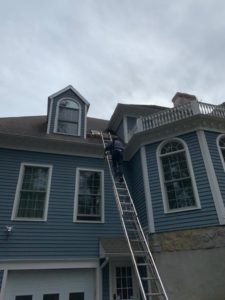How do bats get into homes? That’s a great question, but it’s not easily answered. The reason is that every home is different. However, there are some places that just seem to come up year after year.
Typical bat entrances
The average size gap that a Little Brown bat needs to get into a home is about 3/8″. To put this into perspective when we do a bat exclusion we seal areas that the average small finger can fit into. Now go outside and look at all the areas that this could be the case, not an easy task. The next problem with bat entrances is that the gaps they use are never in easy areas to get to. In fact, some homes can’t be done without the help of a mechanical lift.
Inspection the first step
When providing a bat inspection the trained eye will be able to instantly identify areas where bats are likely get in. Of these areas the most common are where dormer meet the roof, changes in roof pitch, gaps around flashing and chimney frames. In every case at some point a ladder is going to be needed so that a more thorough inspection can be performed and work can begin.
Bats don’t do much damage
While bats aren’t welcome in a home they actually don’t do any damage to the structure. In fact, when sealing a structure against the intrusion of bats most professionals use a special weather resistant foam. Bats are non chewers. The true damage from bats comes from their fecal matter (guano) and urine. For the homes that have bats the damage is likely to be located in the attic and it will be limited to insulation and drywall. How bad the damage is and whether the insulation needs to be replaced is going to be different at every home.
Personal safety and bats
Using ladders isn’t the only safety measure that must be taken into account when dealing with bats. Animals like bats and birds can infect humans with a disease called histoplasmosis. This is an upper respiratory disease that can be contracted when working around droppings unprotected. It’s important to remember this as before any cleaning takes place the droppings should be wet down with a solution of bleach and water. This will effectively kill viruses that may be present.
In some cases where minimal droppings are present it may be beneficial to leave them alone. The droppings from animals become more hazardous once they fossilize and become airborne.
The final steps to getting bats out

In order to complete a bat exclusion it will take 4 steps
- Inspection
- Installation of one ways doors that will allow bats to exit safely
- Sealing all the remaining areas where bats could enter the structure
- Returning 7-14 days after the initial install of a one way door to remove it and seal the area
Safety, again
Getting access to the areas that need to be excluded is tough work as bats never seem to infest homes that are easy to get to. The picture to the right is a one taken in the fall of 2019 of me installing a one-way door at a dormer in Brookfield, CT.
